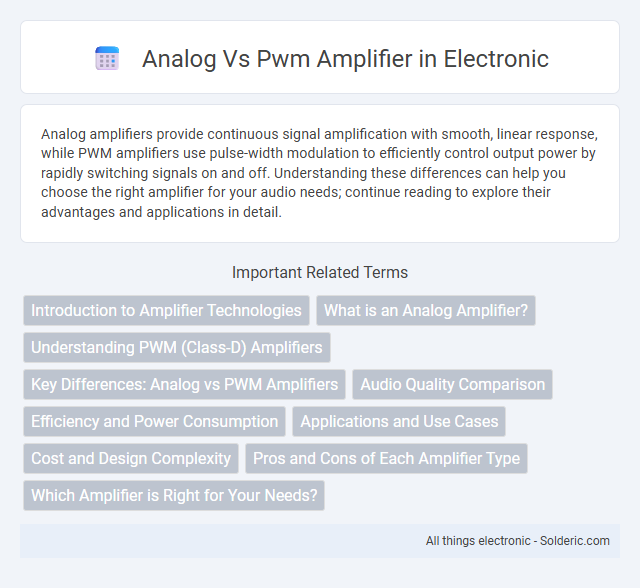Analog amplifiers provide continuous signal amplification with smooth, linear response, while PWM amplifiers use pulse-width modulation to efficiently control output power by rapidly switching signals on and off. Understanding these differences can help you choose the right amplifier for your audio needs; continue reading to explore their advantages and applications in detail.
Comparison Table
| Feature | Analog Amplifier | PWM Amplifier |
|---|---|---|
| Working Principle | Continuous wave amplification | Pulse Width Modulation switching |
| Efficiency | Low to moderate (40%-70%) | High (typically 80%-95%) |
| Heat Generation | High heat dissipation | Minimal heat due to switching |
| Signal Distortion | Lower, more linear output | Potential switching noise, requires filtering |
| Size and Weight | Bulkier and heavier | Compact and lightweight |
| Complexity | Simple design | More complex circuitry required |
| Applications | High-fidelity audio, low power use | High efficiency audio, power amplification |
Introduction to Amplifier Technologies
Analog amplifiers use continuous signal modulation to amplify audio waves, delivering natural, warm sound ideal for audiophiles seeking authentic audio reproduction. PWM (Pulse Width Modulation) amplifiers operate by switching transistors on and off rapidly, providing higher energy efficiency and reduced heat generation, making them popular in portable and power-sensitive devices. Your choice between analog and PWM amplifiers depends on whether sound fidelity or efficiency is a priority for your audio setup.
What is an Analog Amplifier?
An analog amplifier continuously varies its output voltage or current in direct proportion to the input signal, preserving the waveform's shape and fidelity. It operates through linear components such as transistors and resistors, providing high-quality audio amplification with minimal distortion. Unlike PWM amplifiers, analog amplifiers are favored for applications requiring precise sound reproduction and smooth signal amplification.
Understanding PWM (Class-D) Amplifiers
PWM (Class-D) amplifiers utilize pulse-width modulation to convert input signals into high-frequency digital pulses, which efficiently drive the output transistors with minimal heat dissipation compared to traditional analog amplifiers. These amplifiers achieve higher power efficiency--often exceeding 90%--by rapidly switching transistors on and off, reducing energy loss during operation. The compact size and reduced thermal management requirements make PWM amplifiers ideal for applications demanding lightweight, energy-efficient audio solutions.
Key Differences: Analog vs PWM Amplifiers
Analog amplifiers operate by continuously varying the output voltage in direct proportion to the input signal, providing smooth and high-fidelity audio reproduction. PWM (Pulse Width Modulation) amplifiers switch the output transistors on and off at high frequencies, controlling the pulse width to replicate the input signal, resulting in higher efficiency and reduced heat dissipation. Understanding these key differences helps you choose the right amplifier based on your preference for sound quality or energy efficiency.
Audio Quality Comparison
Analog amplifiers deliver a warm, natural sound characterized by smooth harmonic distortion and a continuous waveform, which many audiophiles prefer for its authentic audio reproduction. PWM amplifiers, or Class D amplifiers, offer high efficiency and low heat generation but can introduce switching noise and quantization errors that may affect the audio fidelity. Advances in digital signal processing and filtering have significantly improved PWM amplifier sound quality, allowing them to approach the audio clarity of analog designs in modern high-end audio systems.
Efficiency and Power Consumption
PWM amplifiers typically offer higher efficiency and lower power consumption compared to analog amplifiers due to their switching operation, which minimizes energy loss as heat. Analog amplifiers continuously operate in the linear region, resulting in greater power dissipation and reduced efficiency. Choosing a PWM amplifier can help your audio system run cooler and consume less electricity, making it ideal for energy-sensitive applications.
Applications and Use Cases
Analog amplifiers excel in high-fidelity audio systems and sensitive instrumentation, delivering continuous signal amplification with minimal distortion. PWM amplifiers are ideal for power-efficient applications like motor drives, audio speakers in portable devices, and renewable energy systems due to their high efficiency and compact design. Your choice depends on whether precision or energy efficiency is the priority in your specific application.
Cost and Design Complexity
Analog amplifiers generally have lower initial costs and simpler design due to fewer components and straightforward circuitry. PWM amplifiers, while offering higher efficiency and power output, involve increased design complexity with integrated digital control and filtering stages. Your choice depends on balancing upfront costs against long-term performance and efficiency needs.
Pros and Cons of Each Amplifier Type
Analog amplifiers offer high-fidelity sound reproduction with minimal distortion, making them ideal for audiophiles and professional audio equipment, but they tend to be bulkier and less energy-efficient. PWM (Pulse Width Modulation) amplifiers, also known as Class D amplifiers, provide superior energy efficiency and compact size, making them suitable for portable and battery-powered devices, yet they can introduce electromagnetic interference and slight audio quality degradation. Choosing between analog and PWM amplifiers depends on the specific application requirements, balancing sound quality, power efficiency, size, and potential noise issues.
Which Amplifier is Right for Your Needs?
Choosing between an analog and PWM amplifier depends on your audio quality preferences and power efficiency requirements. Analog amplifiers deliver warm, natural sound ideal for audiophiles and music enthusiasts seeking high-fidelity output. PWM amplifiers excel in energy efficiency and compact design, making them suitable for portable devices and applications where reduced heat generation and longer battery life are priorities.
analog vs pwm amplifier Infographic

 solderic.com
solderic.com